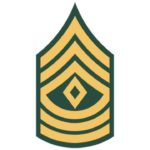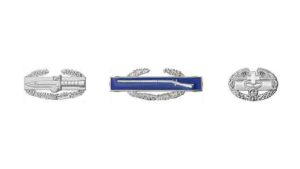First Sergeant
The rank of “First Sergeant” (abbreviated as 1SG), a United States Army senior noncommissioned officer rank, came into existence in 1781. During this time, the title referred to the senior sergeant of a company but it wasn’t exactly a separate rank. It was combined with the separate rank known as “orderly sergeant” in 1851. Today, the First Sergeant is an established rank at the pay grade of E-8 and remain the senior enlisted member of a company sized unit.

 The design of the First Sergeant rank consists of three arched stripes or “chevrons” (standard sergeant insignia) and three curved stripes “rockers” below them. The configuration is often referred to as having “three up and three down. The space in the center that is created by the configuration is occupied by a diamond shaped device known as a “pierced lozenge”. In appearance, the First Sergeant rank insignia is identical to that of the Master Sergeant with the exception of the lozenge or “diamond” that appears in the middle of the First Sergeant rank insignia.
The design of the First Sergeant rank consists of three arched stripes or “chevrons” (standard sergeant insignia) and three curved stripes “rockers” below them. The configuration is often referred to as having “three up and three down. The space in the center that is created by the configuration is occupied by a diamond shaped device known as a “pierced lozenge”. In appearance, the First Sergeant rank insignia is identical to that of the Master Sergeant with the exception of the lozenge or “diamond” that appears in the middle of the First Sergeant rank insignia.
The rank is one pay grade above the rank of Sergeant First Class (SFC) pay grade E-7. It is equivalent in rank to the Master Sergeant at pay grade E-8. It is one rank below the ranks of Sergeant Major (SGM) or command sergeant major (CSM) at pay grade E-9.
Master sergeants are laterally appointed to first sergeant upon selection by the senior leadership at Department of the Army, while qualified sergeants first class are promoted, depending on available billets and opportunities. A promotable Sergeant First Class or a Master Sergeant may be selected for promotion to or appointment as a First Sergeant and may assume the duty. In short, an individual must occupy the company leadership position to hold this rank. Otherwise, an E-8 would revert to the rank of Master Sergeant.
The Role of the First Sergeant
The First Sergeant is the highest ranking non-commissioned officer that still performs “hands-on” leadership in the United States Army. The importance of the position is exemplified in a phrase used in the German Army, they call the First Sergeant the “Father of the unit”. This is just as true in the U.S. Army. Although equal in grade to rank of master sergeant (MSG), personnel at these two ranks typically have very different responsibilities.
An Army first sergeant is generally senior to a master sergeant when it comes leadership with the Master Sergeant usually operating in a staff role but, in some cases, a master sergeant may have more general military authority. An example can be seen in the case of a Master sergeant in charge of a military police (MP) section. In addition to managing all of the daily responsibilities of running the company/unit, the First Sergeant is responsible for the leadership and professional development of their soldiers. This can include the following;
Non-commissioned officer development – providing career development counseling and mentoring provided to subordinate noncommissioned officers and overseeing these same activities in regards to those subordinate noncommissioned officers providing the same to personnel below them.
Grooming of enlisted soldiers for professional and career development – ensuring the soldiers under their leadership meet the Army’s grooming standards and are purporting themselves in a professional manner. Additionally, ensuring that soldiers are receiving the required training and taking advantage of opportunities for specialized trainings and assignments that can serve to further their military career.
Manage pay issues and supervise administrative issues – Ensuring that soldier’s under their leadership are paid correctly and assisting in the resolution of pay issues. Also ensuring that soldiers are meeting their financial obligations. Additionally, ensuring that administrative issues are handled appropriately and assisting in the resolution of any that may occur.
Reenlistment – The First Sergeant is key in the area of reenlistment! Reenlistment is equivalent to retention in the business sense. In short, their efforts reduce turnover, improved morale, reduced acquisition and training time, increase overall productivity, reduced costs. They help the Army keep and improve what took so much time and effort to create and build.
Disciplinary actions – First sergeants are the first step in disciplinary actions such as an Article 15 (non-judicial punishment) proceeding. Any form of punishment that may be applied to individual soldiers that doesn’t require a court martial or similar proceedings starts with the First Sergeant.
Fun Fact: A First Sergeant may place a soldier under arrest and even restrict them to their quarters in certain cases.


Commonly referred to as “Top”, “Top Sergeant”, “Top Soldier”, “Top Kick”, or “First Shirt”, due to their seniority and position at the top of the company’s enlisted ranks, it’s obvious that the personnel at this rank represent the best examples of a noncommissioned officer. What this means becomes apparent in the Non-Commissioned Officer’s (NCO) Creed. The NCO Creed reads;
No one is more professional than I. I am a noncommissioned officer, a leader of Soldiers. As a noncommissioned officer, I realize that I am a member of a time honored corps, which is known as “The Backbone of the Army.” I am proud of the Corps of Noncommissioned Officers, and will at all times conduct myself so as to bring credit upon the Corps, the military service, and my country; regardless of the situation in which I find myself. I will not use my grade or position to attain pleasure, profit, or personal safety.
Competence is my watch-word. My two basic responsibilities will always be uppermost in my mind – accomplishment of my mission and the welfare of my Soldiers. I will strive to remain technically and tactically proficient. I am aware of my role as a noncommissioned officer, I will fulfill my responsibilities inherent in that role. All Soldiers are entitled to outstanding leadership; I will provide that leadership. I know my Soldiers, and I will always place their needs above my own. I will communicate consistently with my Soldiers, and never leave them uninformed. I will be fair and impartial when recommending both rewards and punishment.
Officers of my unit will have maximum time to accomplish their duties; they will not have to accomplish mine. I will earn their respect and confidence as well as that of my Soldiers. I will be loyal to those with whom I serve; seniors, peers, and subordinates alike. I will exercise initiative by taking appropriate action in the absence of orders. I will not compromise my integrity, nor my moral courage. I will not forget, nor will I allow my comrades to forget that we are professionals, noncommissioned officers, leaders!
That pretty much says it all!
Summary
The distinct rank and insignia of the First Sergeant represent so much more than a pay grade. Just as with a father in a family, they can be (as some may not realize) regarded caregivers. And, just like a father, a rock solid First Sergeant serves to;
- Offer developmentally specific provisions to their soldiers and are impacted themselves by doing so.
- Play an integral role in reducing behavior and psychological problems in young soldiers.
- Through increased involvement may help increase a soldier’s social stability, educational achievement, and their potential to have solid relationships.
- Encourage soldiers to be more curious about the world around them and develop greater problem solving skills.
- Cause soldiers to perceive themselves to be more cognitively and physically competent than their peers without great senior leadership.
By effectively managing all of the daily responsibilities of running the company/unit and being responsible for the leadership and professional development of their soldiers, the First Sergeant “Makes it Happen”.


